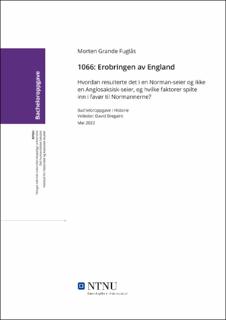| dc.contributor.advisor | Bregaint, David | |
| dc.contributor.author | Fuglås, Morten Grande | |
| dc.date.accessioned | 2022-06-25T17:20:29Z | |
| dc.date.available | 2022-06-25T17:20:29Z | |
| dc.date.issued | 2022 | |
| dc.identifier | no.ntnu:inspera:110289010:50156654 | |
| dc.identifier.uri | https://hdl.handle.net/11250/3000902 | |
| dc.description.abstract | Bayeux-teppet er et av de mest uvurderlige ikonografiskkilden som har overlevd fra 1000-tallet. Hvor dette er ikke et teppe i det heletatt, men er et broderi. Der forfatter og håndverkere er ukjent. Bevaring av dette verket igjennom tiden har holdt det i såpass god stand at vi, tusen år senere kan bruke dette i å avdekke historiske narrative, til et av de mer interessante og virkningsfulle hendelsene i Anglosaksiske England. Bayeux-teppet viser oss hendelsesforløpet av årene 1064-1066, der det i lengre tid har blitt sett på som Norman-synet for erobringen av England, men som vi skal se er ikke dette tilfellet. Dette er med tanke på hvordan broderiet viser en mer sympatetisk holdning til den tapende siden, med hvordan Harold er fremstilt. Ikke bare som en modig og stolt kriger, men også som en rettmessig arvtager etter Edward Bekjenneren. Samtidig viser Bayeux-teppet kulturelle og sosiale forhold på 1000-tallet i Normandie og England.
I en så politisk komplisert situasjon, hvordan resulterte det i en Norman-seier og ikke en Anglosaksisk-seier, og hvilke faktorer spilte inn i favør til Normannerne?
I denne bacheloroppgaven skal jeg få frem med hjelp av Bayeux-teppet og kontinentale kilder, sammen med tidligere forsking, gi et forklarende bilde frem mot 1066 sitt hendelsesforløp. Der jeg skal forklare de faktorene jeg har bedømt i å være en stor nok faktor i å fremme en Norman-seier i erobringen av England. Der jeg skal forklare krigføring på 1000-tallet som noe mer enn «store slag», hvor slott konstruksjon var et sentralt aspekt med hvordan krigføring utviklet seg på 1000-tallet. Der jeg også skal se på selve Slaget ved Hastings og fremme hvor dette er et mer unikt og komplisert middelalderslag. Dette skal gjøres med å se på hvorfor det varte så lenge, og hvor store påvirkning et hemmet militær hierarkiet har for selve slaget. Et sentralt aspekt i å invadere noen via havet er hvor været og vind har en svært sentral rolle for invasjonstyrker, der i dette tilfellet det bestemte hvem av de invaderende styrkende landet først. | |
| dc.description.abstract | The Bayeux tapestry is one of the most invaluable iconographic sources that has survived from the 11th century. Where this is not a tapestry at all but an embroidery, and the author and the craftsmen are unknown. Preservation of this work overtime has kept it in such a good condition, that a thousand years later we can use it to uncover historical narratives, to one of the more interesting and impactful events in Anglo-Saxon England. The Bayeux tapestry shows us the course of the events of the following years; 1064-1066. Where it has long been seen as the Norman-view of the conquest of England, but as we shall see, this is not the case. The view of how the embroidery shows a more sympathetic attitude towards the losing side, with how Harold is portrayed. Not only as a brave and proud warrior, but also as a rightful heir after Edward the Confessor. At the same time, the Bayeux tapestry shows the cultural and social conditions of the 11th century in Normandy and England.
In such a politically complicated situation, how did it result in a Norman victory and not an Anglo-Saxon victory, and what factors came into play in favor of the Normans?
This bachelor thesis will show with the help of the Bayeux tapestry and continental sources, together with previous research, give an explanatory picture towards the year 1066 course of events. Where I will explain the factors, I have judged to be big enough in promoting a Norman victory in the conquest of England. I will explain warfare in the 11th century as something more than "big battles", where castle construction was a key aspect of how warfare developed in the Middle Ages. Furthermore, I will also look at the Battle of Hastings itself and where this is a more unique and complicated medieval battle. It shall be done by looking at why the battle lasted so long, and how much influence a crippled military hierarchy had on the battle itself. A key aspect in invading someone by the sea, is when the weather plays a very crucial role for invading the forces. In this case, it decides which of the invading armies arrives first. | |
| dc.language | nob | |
| dc.publisher | NTNU | |
| dc.title | 1066: Erobringen av England | |
| dc.type | Bachelor thesis | |
